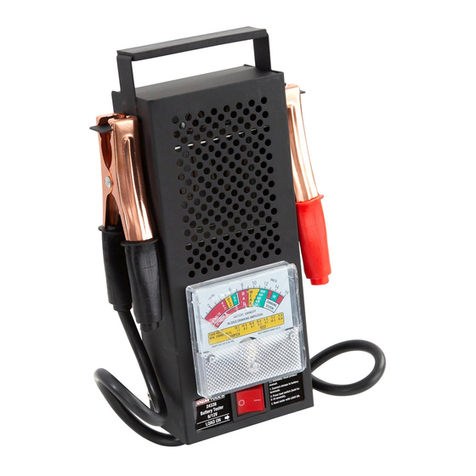
4
Operating Instructions and Parts Manual 24336
3/19
2019 OEMTOOLS™
500 AMP CARBON PILE
BATTERY TESTER
CONTACT US
3580 E. Raines Road, Suite 3, Memphis, TN 38118
Tel: 1-866-458-2472
www.oem-tools.com
OEMTOOLS™ LIMITED LIFETIME WARRANTY
For as long as you own this OEMTOOLS™ product, if you find any defect in material or workmanship, through normal usage, return it to the
place of purchase or to OEMTOOLS™ for repair or replacement at our discretion. In order to obtain this service, send your tool and proof of
purchase (transportation pre-paid) to:
OEMTOOLS™ Q.A. Dept., 3580 E. Raines Road #3, Memphis, TN 38118.
We will not be responsible for lost or damaged goods during transportation; please insure your package. If our inspection verifies the defect,
we will repair or replace the product, or we may elect to refund the purchase price if we cannot readily and quickly provide you with a
replacement. We will return repaired products at our expense, but if we determine there is no defect, or that the defect resulted from causes
not within the scope of our warranty, then you must bear the cost of returning the product.
OEMTOOLS™ does not provide warranty for products labeled other than OEM® or OEMTOOLS™. OEMTOOLS™ will not provide any
warranty for products subjected to abnormal use. Abnormal use includes (but is not limited to) abuse, accident, alteration, neglect, and
unauthorized or unreasonable use or repairs. This warranty does not cover bits, blades, files, batteries, or calibration. We recommend that
you maintain your tools and sharpen or replace blades, bits, files, and batteries as necessary. OEMTOOLS™ reserves the right to make any
changes in construction or design at any time without any obligation in incorporating such changes to tools or equipment previously sold.
OEMTOOLS™ makes every effort to ensure that its products meet high quality and durability standards, and warrants to the original
purchaser that this product is free from defects in materials and workmanship. This warranty does not apply to damage due directly or
indirectly to misuse, abuse, negligence or accidents, repairs or alterations outside our facilities, criminal activity, improper installation, normal
wear and tear, or to lack of maintenance.
We shall in no event be liable for death, injuries to persons or property, or for incidental, contingent, special or consequential damages
arising from the use of our product. Some states do not allow the exclusion or limitation of incidental or consequential damages, so the
above limitation of exclusion may not apply to you. THIS WARRANTY IS EXPRESSLY IN LIEU OF ALL OTHER WARRANTIES, EXPRESS OR
IMPLIED, INCLUDING THE WARRANTIES OF MERCHANTABILITY AND FITNESS. This warranty gives you specific legal rights, and you may
also have other rights, which vary from state to state.
Don’t forget to register your new OEMTOOLS™ product at www.oem-tools.com.
BATTERY CONDITION ANALYSIS
LOAD TEST / 15 Sec. (Display Reading)
Battery Condition
OK (Green area)
Battery Capacity is good. May or may not be fully charged.
Check the charge state by testing the Specific Gravity (SG)
with a Hydrometer. If SG is less than full charge, check for
possible charging system trouble. Recharge to full level.
BAD (Red area)
If the DC Volt Meter needle is failing, the battery is
defective or has a bad cell. For a quick check, turn the
Load Knob down (counterclockwise) and note DC Volts
Meter reaction. If voltage recovers to its full potential after
only a few seconds, the battery is probably defective. If the
voltage recovers slowly, the battery may only be run down.
Check specific gravity level, recharge, and retest.
CHARGING SYSTEM (Alt. & Reg. Test)
If the DC Volt Meter needle reads OK, charging system
is functional. If it falls on the low red or high red areas,
charging system may be malfunctioning.
STARTER MOTOR TEST
If starting your vehicle is difficult, you may have unnecessary
starter motor draw, which dramatically shortens battery life.
This test identifies starter motor performance.
1. Make sure your engine is running at normal operating
temperature, and that the battery is fully charged and in
good condition.
2. Connect the Red Clamp to the positive (+) terminal
post on the battery. Connect the Black Clamp to the
negative (-) terminal post on the battery.
3. Turn the Load Knob (C) counterclockwise to the OFF
position.
4. Disable the engine to make sure the car will not start.
Refer to your vehicle’s service manual.
5. While watching the DC Volt scale, crank the engine
briefly to determine the voltage reading during
cranking. A display reading of 9 volts or less indicates
excessive current draw. This may be caused by a bad
connection of a failing starter motor, or the battery
is too small for the vehicle’s requirements. Consult a
qualified mechanic.
6. When starter motor test is complete, remove Black (-)
Clamp from battery first; then remove Red (+) Clamp.
INSPECTION, MAINTENANCE, AND CLEANING
1. Periodically check all nuts, bolts, and screws for
tightness.
2. Store in a clean, dry location.
3. Clean the outside of the unit with a damp cloth.
Never use solvents to clean any parts of this tool. Use
compressed air to blow out debris from the load vents.
Allow tool to dry completely before use.
4. After each use, clean the cable clamps of any possible
battery electrolyte. Apply a thin coat of silicon grease to
prevent corrosion.






















